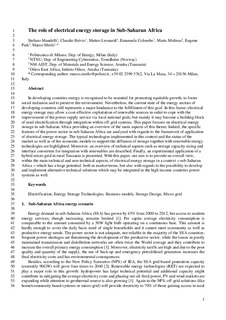| dc.contributor.author | Mandelli, Stefano | |
| dc.contributor.author | Brivio, Claudio | |
| dc.contributor.author | Leonardi, Matteo | |
| dc.contributor.author | Colombo, Emanuela | |
| dc.contributor.author | Molinas Cabrera, Maria Marta | |
| dc.contributor.author | Park, Eugene | |
| dc.contributor.author | Merlo, Marco | |
| dc.date.accessioned | 2017-02-20T09:11:54Z | |
| dc.date.available | 2017-02-20T09:11:54Z | |
| dc.date.created | 2017-01-17T12:23:28Z | |
| dc.date.issued | 2016 | |
| dc.identifier.citation | Journal of Energy Storage. 2016, 8 287-299. | nb_NO |
| dc.identifier.issn | 2352-152X | |
| dc.identifier.uri | http://hdl.handle.net/11250/2431303 | |
| dc.description.abstract | In developing countries, energy is recognized to be essential for promoting equitable growth, fostering social inclusion and preserving the environment. Nevertheless, the current state of the energy sectors of developing countries still represents a major hindrance to the fulfillment of this goal. In this frame, electrical energy storage may allow a cost-effective exploitation of renewable sources in order to cope with the improvement of the power supply service via local national grids, but mainly it may become a building block of rural electrification through integration within off-grid systems. This paper focuses on electrical energy storage in sub-Saharan Africa providing an overview of the main aspects of this theme. Indeed, the specific features of the power sector in sub-Saharan Africa are analyzed about the framework of application of electrical energy storage. The typical technologies implemented in this context and the status of the market as well as of the economic models to support the diffusion of storage together with renewable energy technologies are highlighted. Moreover, an overview of technical aspects such as storage capacity sizing and interface converters for integration with renewables are described. Finally, an experimental application of a hybrid micro-grid in rural Tanzania is presented. With this paper, our aim is to provide an overall view, within the main technical and non-technical aspects, of electrical energy storage in a context – sub-Saharan Africa – which has a huge potential, both in market terms, but also with regards to the possibility to develop and implement alternative technical solutions which may be integrated in the power systems of high income countries as well. | |
| dc.language.iso | eng | nb_NO |
| dc.rights.uri | https://creativecommons.org/licenses/by-nc-nd/4.0/ | |
| dc.title | The role of electrical energy storage in sub-Saharan Africa | nb_NO |
| dc.type | Journal article | nb_NO |
| dc.type | Peer reviewed | nb_NO |
| dc.source.pagenumber | 287-299 | nb_NO |
| dc.source.volume | 8 | nb_NO |
| dc.source.journal | Journal of Energy Storage | nb_NO |
| dc.identifier.doi | 10.1016/j.est.2015.11.006 | |
| dc.identifier.cristin | 1429599 | |
| dc.subject.keyword | Electrification; Energy storage technologies; Business models; Storage design; Micro-grid | |
| dc.description.localcode | © 2016. This manuscript version is made available under the CC-BY-NC-ND 4.0 license http://creativecommons.org/licenses/by-nc-nd/4.0/ available 1 november 2018 | nb_NO |
| cristin.unitcode | 194,63,25,0 | |
| cristin.unitname | Institutt for teknisk kybernetikk | |
| cristin.ispublished | true | |
| cristin.fulltext | postprint | |
| cristin.qualitycode | 1 | |

